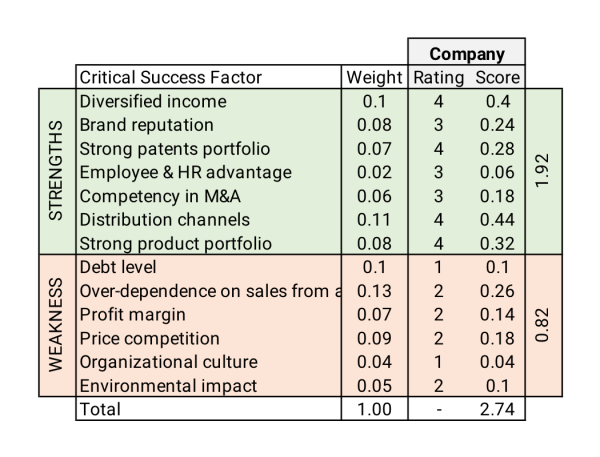Internal Factor Evaluation (IFE) Matrix is a strategy tool used to evaluate firm’s internal environment and to reveal its strengths as well as weaknesses. The internal and external factor evaluation matrices have been introduced by Fred R. David in his book Strategic Management[1]. According to the author, both tools are used to summarize the information gained from company’s external and internal environment analyses.

Internal Factor Analysis
Strengths and weaknesses are used as the key internal factors in the evaluation. When looking for the strengths, ask what do you do better or have more valuable than your competitors have? In case of the weaknesses, ask which areas of your company you could improve and at least catch up with your competitors? The general rule is to identify as many key internal factors as possible.
Weights
Each key factor should be assigned a weight ranging from 0.0 (low importance) to 1.0 (high importance). The number indicates how important the factor is if a company wants to succeed in an industry. If there were no weights assigned, all the factors would be equally important, which is an impossible scenario in the real world. The sum of all the weights must equal 1.0. Separate factors should not be given too much emphasis (assigning a weight of 0.30 or more) because the success in an industry is rarely determined by one or few factors.
Ratings
The ratings in internal matrix refer to how strong or weak each factor is in a firm. The numbers range from 4 to 1, where 4 means a major strength, 3 – minor strength, 2 – minor weakness and 1 – major weakness. Strengths can only receive ratings 3 & 4, weaknesses – 2 and 1. The process of assigning ratings in IFE matrix can be done easier using benchmarking tool.
Score
The score is the result of weight multiplied by rating. Each key factor must receive a score. Total weighted score is simply the sum of all individual weighted scores. The firm can receive the same total score from 1 to 4 in both matrices. The total score of 2.5 is an average score. In internal evaluation a low score indicates that the company is weak against its competitors.
IFE and EFE analyses have little value on their own. You should do both analyses and combine their results to discuss new strategies or for further analysis. They are especially useful when building advanced SWOT analysis, SWOT matrix for strategies or IE matrix.
References
| ↑1 | David, F.R. (2009). Strategic Management: Concepts and Cases. 12th ed. FT Prentice Hall |
|---|




